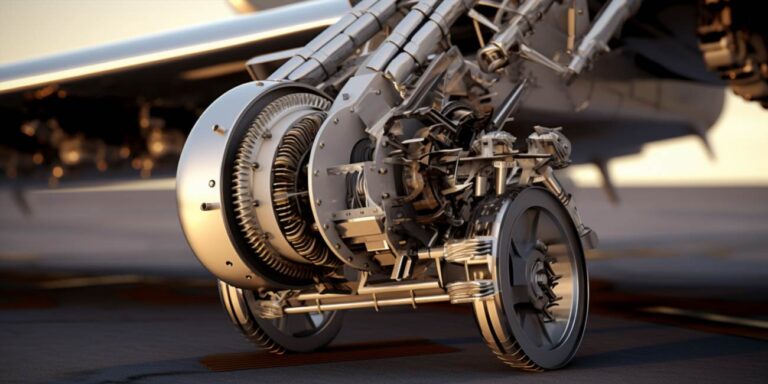The primary purpose of the anti-skid system is to prevent the aircraft’s wheels from locking up during braking. When a pilot initiates the braking process, the anti-skid system constantly monitors the rotational speed of each wheel. If it detects that a wheel is about to lock up, it intelligently modulates the brake pressure applied to that specific wheel, preventing it from seizing.
This intervention is imperative, especially during adverse weather conditions or challenging terrains. The anti-skid system significantly enhances the aircraft’s ability to decelerate smoothly without risking a skid. In turn, this contributes to maintaining directional control and ensures a safe and controlled landing or takeoff.
One of the remarkable features of the anti-skid system is its real-time adaptability. It continuously assesses the conditions of the runway and adjusts its responses accordingly. This adaptability is particularly beneficial when transitioning between different surface types, such as moving from a dry runway to a wet or icy one.
To grasp the intricacies of what is anti-skid system in aircraft, it’s essential to understand the underlying technology. The system relies on sensors that monitor wheel speed, and the information gathered is processed by a dedicated control unit. This unit, equipped with sophisticated algorithms, makes split-second decisions to optimize brake pressure for each wheel independently.
Moreover, the anti-skid system enhances the overall operational efficiency of an aircraft. By preventing skidding and ensuring optimal braking, it minimizes wear and tear on the aircraft’s landing gear components. This not only reduces maintenance costs but also extends the lifespan of crucial parts, contributing to the long-term economic viability of the aircraft.
How anti skid system works in aircraft braking system
In aircraft braking systems, the anti-skid system plays a crucial role in ensuring the safety and efficiency of landings and decelerations. This system is designed to prevent the aircraft’s wheels from locking up during braking, which could lead to skidding and loss of control. The anti-skid system employs sophisticated sensors, valves, and control logic to achieve its objective.
The primary components of the anti-skid system include wheel speed sensors, control units, and brake modulators. Wheel speed sensors continuously monitor the rotational speed of each wheel. These sensors provide real-time data to the control units, which are the brains of the anti-skid system. The control units analyze the wheel speed data and determine if any wheel is on the verge of locking up.
When the control units detect a potential lock-up situation, they send signals to the corresponding brake modulators. Brake modulators are responsible for adjusting the brake pressure on individual wheels. This adjustment is achieved by opening and closing hydraulic valves that regulate the brake pressure. By modulating the brake pressure, the anti-skid system prevents any wheel from locking up, maintaining optimal friction between the tires and the runway.
The operation of the anti-skid system is a continuous feedback loop. As the aircraft decelerates during landing or while taxiing, the wheel speed sensors provide constant updates to the control units. The control units make rapid decisions based on this data, adjusting the brake pressure in real-time to prevent skidding. This dynamic process ensures that the aircraft maintains maximum braking efficiency without sacrificing control.
It’s important to note that the anti-skid system is most critical during landing when the aircraft is touching down on the runway. The rapid deceleration during this phase requires precise control over the braking force to avoid skidding. The anti-skid system not only enhances safety but also contributes to the longevity of the aircraft’s landing gear by preventing excessive wear and tear.
Why is anti skid system important for aircraft safety
An anti-skid system in aircraft plays a critical role in ensuring safe landings and takeoffs by preventing the skidding of tires during various runway conditions. This system is a sophisticated mechanism designed to monitor and control wheel speeds during braking, offering pilots enhanced control and stability.
When an aircraft’s anti-skid system fails, the ramifications can be dire, especially on the runway. A failure of this system can result in loss of traction and control over the aircraft’s movement, potentially leading to skidding during landing or takeoff. This skidding phenomenon poses severe risks, causing unpredictable directional changes and difficulty in stopping the aircraft.
| Consequences of anti-skid system failure: |
|---|
| Increased stopping distance |
| Loss of control over direction |
| Difficulty in steering |
| Potential for runway overrun |
With the failure of the anti-skid system, the aircraft’s ability to decelerate effectively is compromised, resulting in an increased stopping distance that can exceed the runway’s available length. This extended stopping distance raises the risk of a runway overrun, wherein the aircraft could leave the runway surface, potentially causing damage to the aircraft and posing threats to both passengers and personnel.
Moreover, the loss of control over direction and difficulty in steering due to anti-skid system failure heighten the challenges faced by pilots during critical phases of flight. These challenges demand quick thinking and exceptional skills to mitigate the risks and ensure a safe outcome despite the system failure.
Different types of anti skid systems used in modern aircraft
In the realm of aviation, ensuring the safety of aircraft during landing is paramount. One crucial aspect of this safety is the implementation of pneumatic anti-skid systems and hydraulic anti-skid systems. These advanced technologies play a pivotal role in preventing skidding and enhancing overall control during the critical phase of landing.
Let’s delve into the intricacies of these two distinct yet equally vital anti-skid systems. The pneumatic anti-skid system operates based on the principles of air pressure. It utilizes sensors to detect wheel speed and modulates brake pressure accordingly to prevent the wheels from locking up. By doing so, it effectively eliminates the risk of skidding, offering a smoother and safer landing experience.
On the other hand, the hydraulic anti-skid system takes a different approach, relying on hydraulic pressure to achieve its anti-skid functionality. Similarly equipped with sensors, this system constantly monitors wheel speed and adjusts hydraulic brake pressure to maintain optimal traction. The result is a precise and controlled landing, minimizing the potential dangers associated with skidding.
One notable feature of the pneumatic anti-skid system is its responsiveness to rapid changes in wheel speed. The pneumatic system can quickly adapt to varying conditions, ensuring efficient skid prevention across different terrains and weather scenarios. This adaptability is a key strength, especially during challenging landing scenarios.
Conversely, the hydraulic anti-skid system boasts robust reliability and durability. Its hydraulic components are known for their resilience, providing a stable and consistent performance even in demanding conditions. This reliability makes the hydraulic system a preferred choice for various aircraft, particularly those operating in diverse and challenging environments.
It’s essential to note that the choice between a pneumatic anti-skid system and a hydraulic anti-skid system depends on factors such as aircraft design, intended use, and manufacturer preferences. Some aircraft may even incorporate a combination of both systems to capitalize on their respective strengths.






